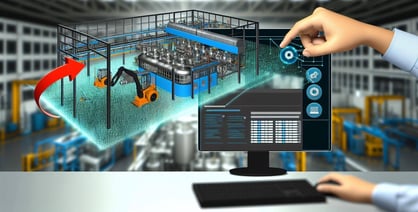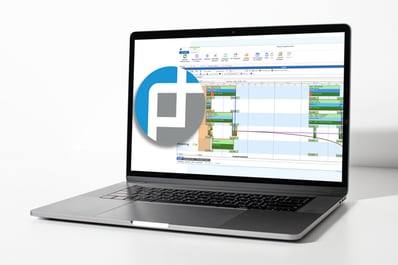Digital Twin Integration with Condition Monitoring Systems
The quest for operational efficiency, cost reduction, and improved productivity remains perpetual. With advancements in technology, industrial manufacturing has seen a paradigm shift towards digitalization, where concepts like Digital Twins and Condition Monitoring Systems (CMS) have emerged as game-changers.
In this blog, we look into the integration of Digital Twins with CMS, exploring how this synergy empowers manufacturing IT in industrial facilities, with a special focus on the integration between PlanetTogether and leading ERP, SCM, and MES systems like SAP, Oracle, Microsoft, Kinaxis, and Aveva.

Digital Twins and Condition Monitoring Systems
Digital Twins
Digital Twin technology involves creating a virtual replica of physical assets, processes, or systems. These digital replicas are not just static models but dynamic entities that mimic the behavior of their real-world counterparts in real-time. By leveraging data from sensors, IoT devices, and other sources, Digital Twins provide a holistic view of assets' performance, enabling better decision-making, predictive maintenance, and optimization.
Condition Monitoring Systems (CMS)
Condition Monitoring Systems are instrumental in assessing the health and performance of equipment and machinery in real-time. Through continuous monitoring of various parameters such as temperature, vibration, pressure, and more, CMS can detect anomalies, predict potential failures, and trigger maintenance actions proactively. This proactive approach minimizes downtime, reduces maintenance costs, and enhances overall equipment effectiveness (OEE).

The Power of Integration: Digital Twins and CMS
The convergence of Digital Twins with Condition Monitoring Systems amplifies their individual capabilities, creating a synergy that revolutionizes manufacturing operations. Let's explore how this integration brings value to industrial facilities:
Real-Time Performance Monitoring
By integrating Digital Twins with CMS, manufacturers gain access to a comprehensive view of equipment performance and health in real-time. Digital Twins simulate the behavior of assets based on live data fed from CMS, allowing operators to monitor critical parameters and detect deviations promptly. This real-time insight enables proactive interventions to prevent equipment failures and optimize operational efficiency.
Predictive Maintenance
One of the most significant benefits of integrating Digital Twins with CMS is predictive maintenance. By analyzing historical data, machine learning algorithms, and real-time sensor data, the combined system can predict equipment failures with high accuracy. Maintenance schedules can be optimized based on actual asset conditions, minimizing unplanned downtime and maximizing asset lifespan.
Optimization of Production Processes
Digital Twins provide a virtual sandbox for simulating production processes and scenarios. By integrating CMS data into Digital Twins, manufacturers can perform "what-if" analyses to optimize production schedules, resource allocation, and workflow efficiency. This integration facilitates predictive analytics, enabling better decision-making to enhance overall manufacturing performance.
Seamless Integration with ERP, SCM, and MES Systems
To fully harness the potential of Digital Twins and CMS, seamless integration with enterprise systems such as ERP, SCM, and MES is crucial. Leading solutions like SAP, Oracle, Microsoft, Kinaxis, and Aveva offer robust platforms for managing manufacturing operations, supply chain logistics, and resource planning. Integrating Digital Twins and CMS with these systems streamlines data exchange, ensuring that insights from the shop floor align with business objectives and strategic planning.

PlanetTogether Integration: Bridging the Gap
PlanetTogether, a leading production planning and scheduling software, plays a pivotal role in orchestrating manufacturing operations. Its advanced capabilities enable manufacturers to optimize production schedules, allocate resources efficiently, and respond dynamically to changing demands. When integrated with Digital Twins and CMS, PlanetTogether becomes the linchpin that connects operational insights with production planning and execution.
Benefits of PlanetTogether Integration
Dynamic Scheduling: By leveraging real-time data from Digital Twins and CMS, PlanetTogether can adjust production schedules dynamically to accommodate changes in equipment status, resource availability, or demand fluctuations.
Optimized Resource Allocation: Integration with Digital Twins allows PlanetTogether to optimize resource allocation based on equipment health and performance metrics. This ensures that assets are utilized effectively without compromising quality or efficiency.
Predictive Planning: With access to predictive maintenance insights from CMS, PlanetTogether can incorporate maintenance activities into production schedules proactively. This predictive planning minimizes disruptions and maximizes throughput.
Data-Driven Decision Making: By integrating with ERP, SCM, and MES systems, PlanetTogether ensures that production plans are aligned with business objectives and market demand. This holistic approach enables data-driven decision-making across the entire value chain.

Implementation Best Practices
To realize the full potential of Digital Twin integration with Condition Monitoring Systems, manufacturing IT teams should follow these best practices:
Define Clear Objectives: Clearly outline the goals and objectives of the integration initiative, whether it's improving equipment reliability, reducing maintenance costs, or optimizing production efficiency.
Select the Right Technologies: Choose Digital Twin and CMS solutions that align with your manufacturing needs and infrastructure. Ensure compatibility and scalability to accommodate future growth.
Collaborate Across Departments: Foster collaboration between IT, operations, maintenance, and engineering teams to ensure a holistic approach to digitalization. Cross-functional input is essential for identifying requirements and validating solutions.
Ensure Data Quality and Security: Establish robust data governance practices to maintain data integrity, confidentiality, and availability. Implement cybersecurity measures to protect sensitive information and prevent unauthorized access.
Provide Training and Support: Invest in training programs to familiarize users with the integrated systems and tools. Offer ongoing support to address technical challenges and optimize usage.
Monitor Performance and Iterate: Continuously monitor the performance of the integrated solution and gather feedback from stakeholders. Iterate based on insights gained to drive continuous improvement.
The integration of Digital Twins with Condition Monitoring Systems heralds a new era of efficiency, reliability, and agility in industrial manufacturing. By combining real-time insights with advanced analytics and predictive capabilities, manufacturers can optimize operations, minimize downtime, and stay ahead of competition. Integration with leading ERP, SCM, and MES systems like SAP, Oracle, Microsoft, Kinaxis, and Aveva ensures that operational excellence aligns with strategic objectives, driving sustained growth and profitability.
With PlanetTogether serving as the catalyst for bridging the gap between shop floor data and production planning, manufacturers can unlock the full potential of digital transformation and thrive in the Industry 4.0 era.
Are you ready to take your manufacturing operations to the next level? Contact us today to learn more about how PlanetTogether can help you achieve your goals and drive success in your industry.
Topics: Industrial Manufacturing, PlanetTogether Software, Integrating PlanetTogether, Optimized Resource Allocation, Data-Driven Decision-Making, Dynamic Scheduling, Real-Time Insights, Digital Twin Technology, Predictive Planning




















LEAVE A COMMENT